These easy cheese and onion pasties with potato are delicious vegetarian Cornish pasties that are hard to beat. The generous and flavourful filling plus the crisp yet tender shortcrust pastry makes these cheese pasties practically irresistible.
Meat-eaters will enjoy my beef pasties with optional horseradish.
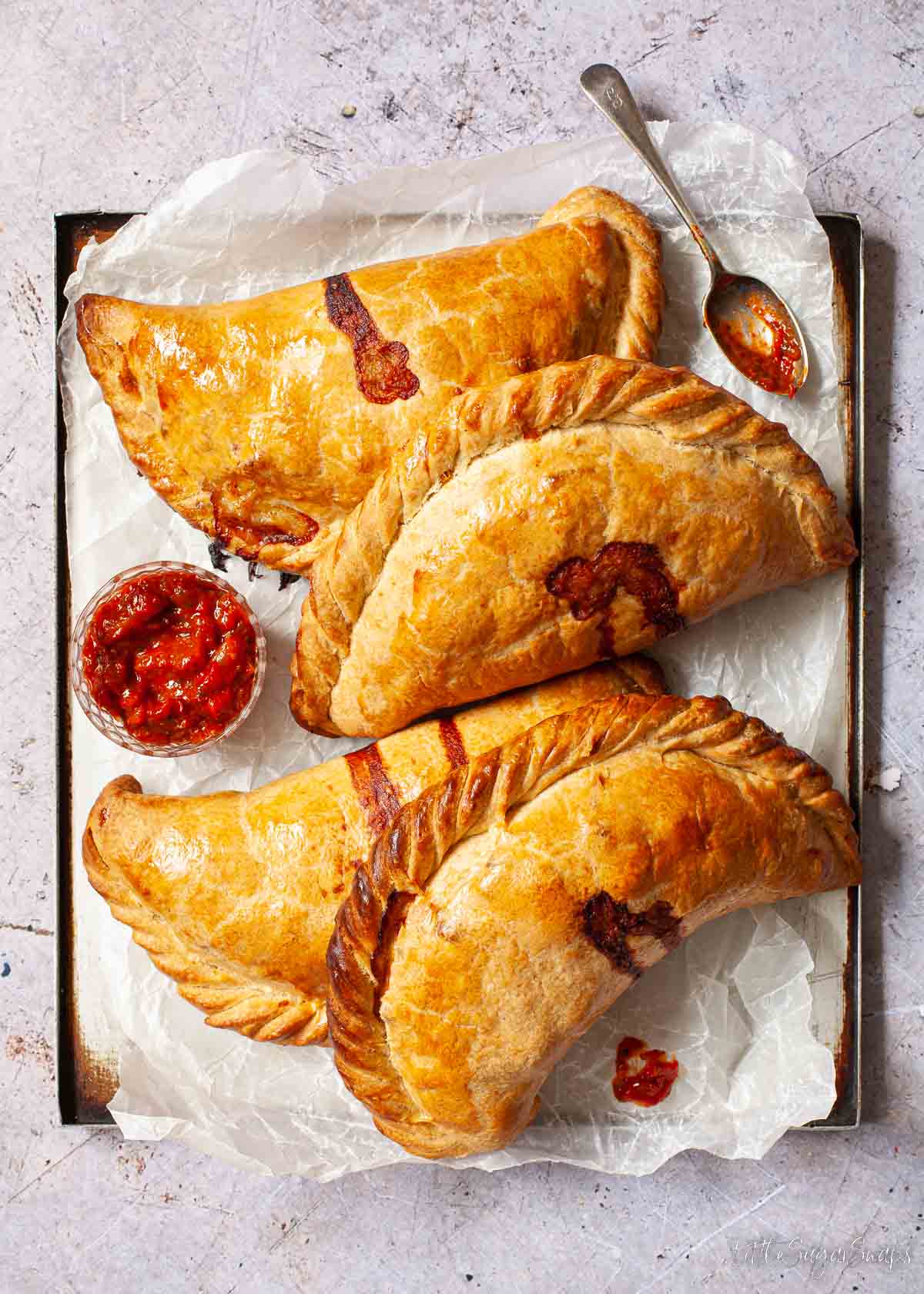
Want to Save This Recipe?
Why you’ll love these cheese pasties
There are plenty of reasons why you’ll enjoy making and devouring these cheese and onion pasties:
- They are large and stuffed to bursting point with ingredients making them wonderfully filling.
- But, since the filling does not need to be cooked prior to use, the recipe is relatively straightforward.
- Rather like a traditional Cornish pasty, these cheese pasties come well seasoned with black pepper for that hit of warmth in the filling.
- The shortcrust pastry is robust, making it possible to hold these pasties in your hand as they are eaten.
Cheese and onion pasties with potato are a fabulous meat-free answer to Cornish pasties. They are chock-full of filling and come encased in a robust shortcrust pastry that holds its shape well.
If you love a good pasty but don’t always fancy a meaty filling, then these vegetarian pasties are a great option.
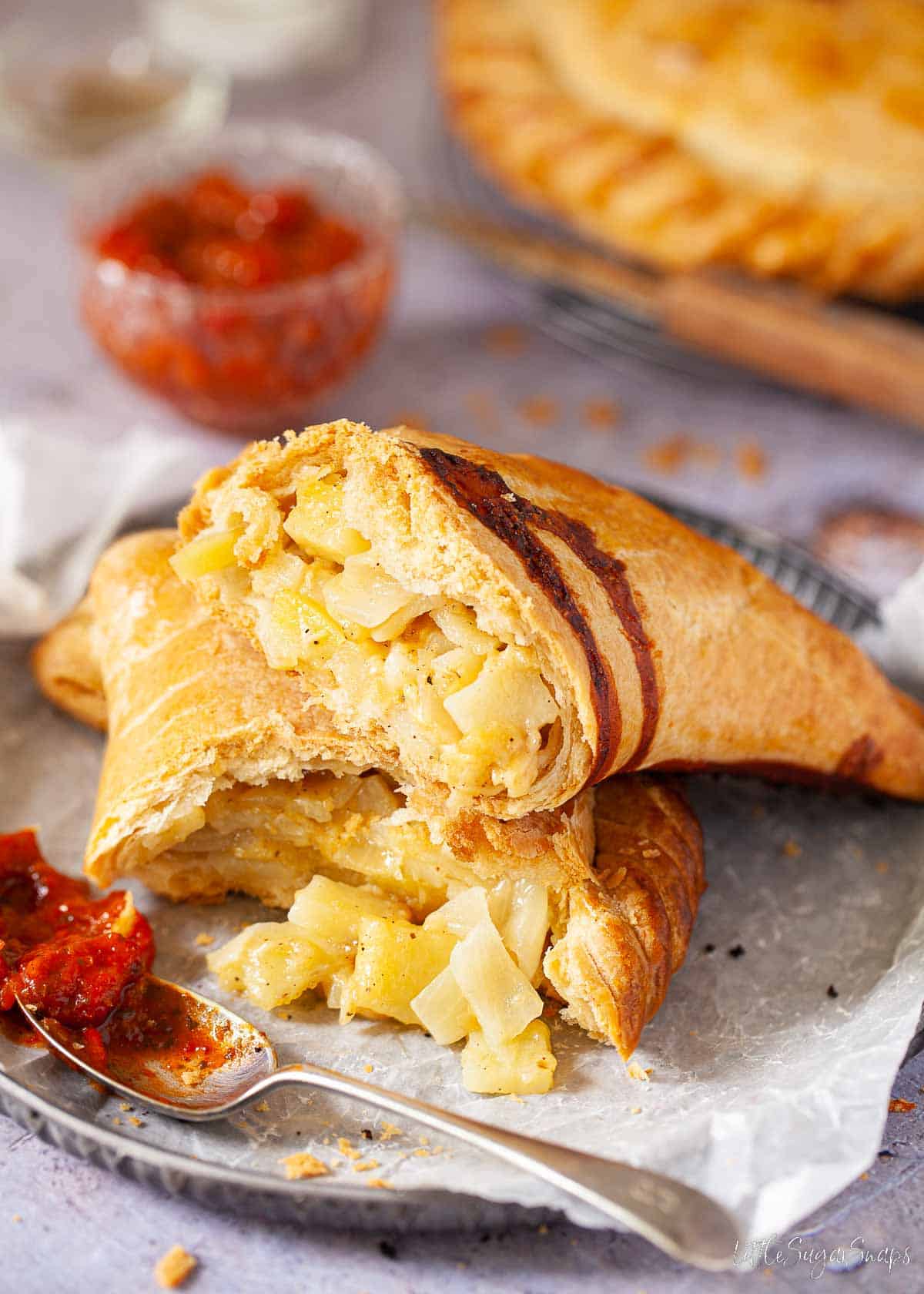
Find plenty more savoury options in my collection of pastry recipes.
Are these like Greggs cheese pasties?
No, they are not. I’ve never had a Greggs cheese pasty, so I have not tried to replicate that bake in any way. Instead, I’ve developed a recipe more akin to vegetable Cornish pasties.
There are a number of obvious differences between my cheese and onion pasties and the Greggs cheese pasty:
- The pastry – my cheese and onion pasties are encased in shortcrust pastry, just like a true Cornish pasty would be. Greggs, however, use puff pastry.
- The shape – Greggs cheese and onion pasties resemble a slice rather than a classic pasty shape.
- There’s also only one type of cheese present in my recipe for cheese pasties whereas Greggs uses a blend of numerous kinds of cheese.
- Unlike the Greggs version, I’ve also included potatoes in my cheese pasties.
Of course, I cannot claim that these are authentic vegetarian Cornish pasties because genuine Cornish pasties have protected status. A true Cornish pasty must be made in Cornwall and they must also contain meat.
So, clearly, whether a pasty that contains no meat should really be called a vegetarian Cornish pasty at all is a bit of a moot point. But I’m not here to get pedantic. I’m just here to deliver some delicious cheese and onion pasties.
Ingredients notes
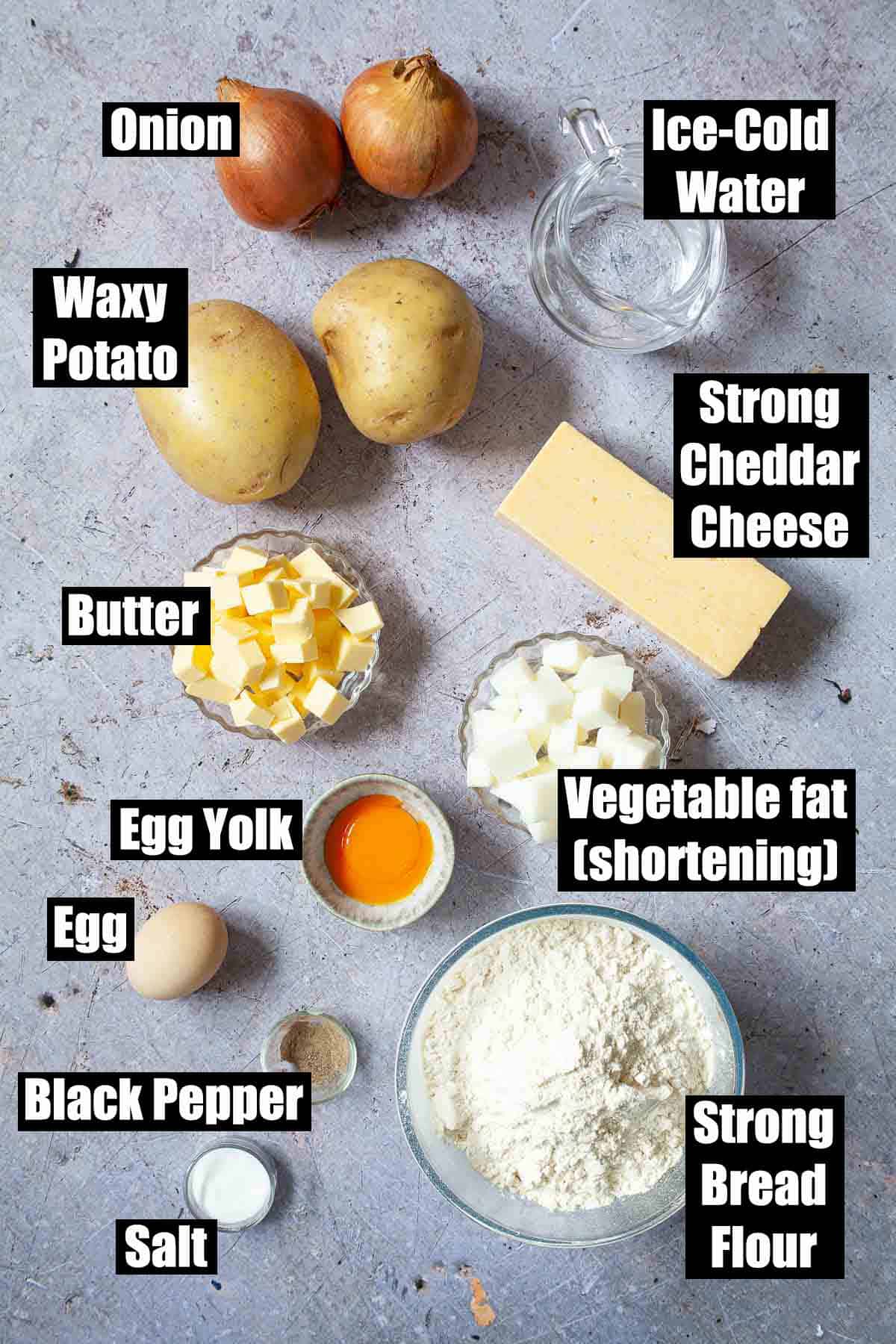
Strong bread flour: this is by far the best flour to use when making a savoury pasty. It creates a strong yet pliable dough that can be filled, sealed and crimped easily. Once baked, the pastry will be strong enough for the pastry to be eaten hand-held without falling apart.
Note that the use of strong bread flour does mean that the dough will need to be kneaded for 3-4 minutes until elastic and it will then need to rest in the fridge for 3 hours, but the result is entirely worth this extra effort and time.
Fat: a mixture of butter and vegetable fat (such as Trex) is used to replicate the pastry used in an authentic Cornish pasty. Technically, a true Cornish pasty would use lard rather than vegetable fat, but I’ve made this easy switch to ensure that these are in fact vegetarian pasties.
Onion: white onion is the best option here. Put aside those fancier red onions and stick with the classic.
Potato: pick a waxy variety that will stay firm and not turn mushy as it cooks. You want it to retain its shape as these cheese and potato pasties cook.
Cheese: use mature cheddar cheese for a full and thoroughly enjoyable cheesy flavour that pairs beautifully with the onion.
Step by step instructions
It’s not difficult to make this cheese, onion and potato pasty recipe and the process is easily broken down into 3 stages:
Make the pastry
- Rub the fat into the flour and salt until it resembles breadcrumbs.
- Add the egg yolk and ¾ of the water. Mix with a blunt knife until a dough forms, adding more of the water as necessary.
- Knead on a lightly floured worktop for 3-4 minutes until the dough begins to feel elastic.
- Shape into a disc and wrap in clingfilm and chill for at least 3 hours. Bring out of the fridge 30 minutes prior to rolling out.
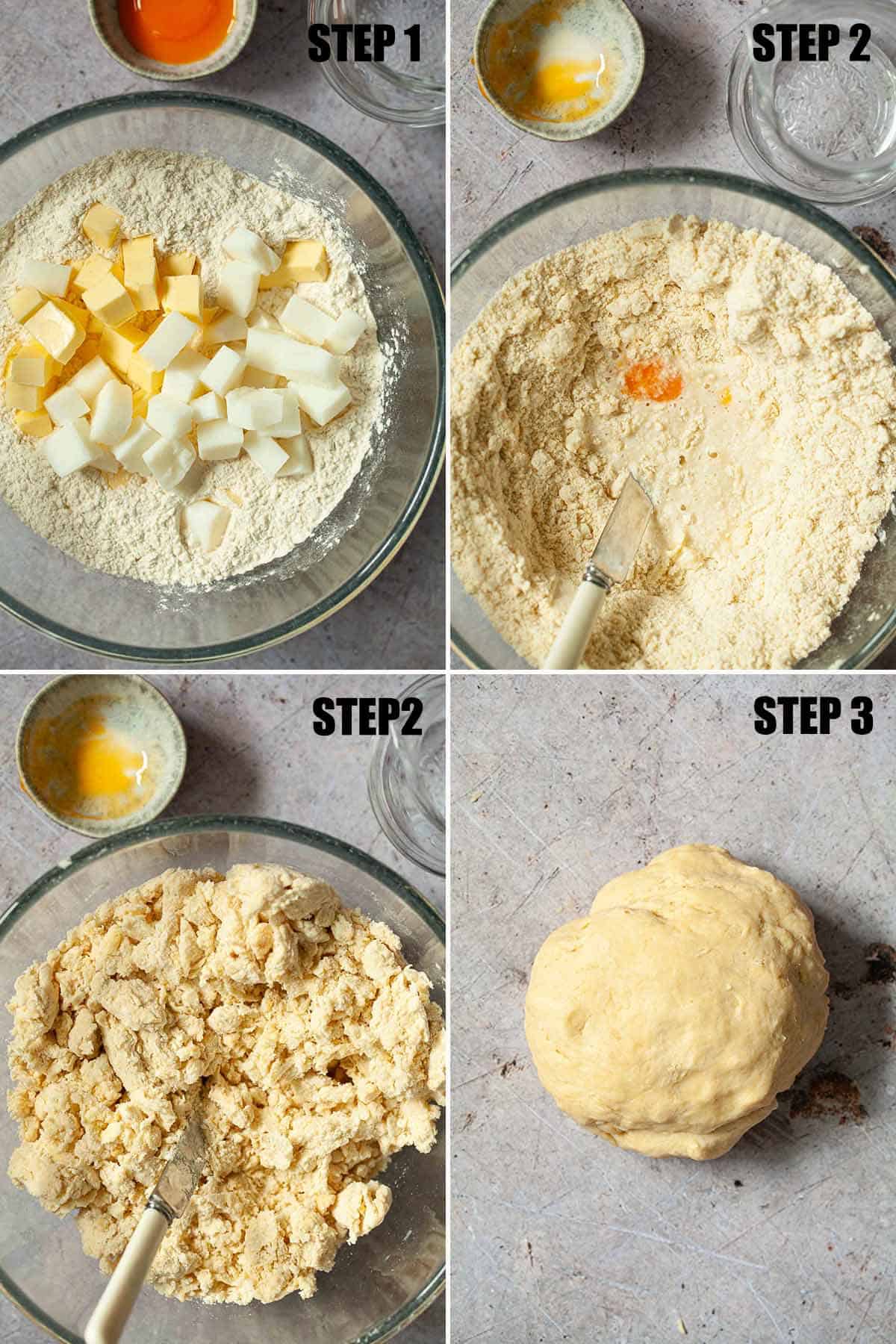
Make the filling
- Slice the potato and onion into thin pieces in line with the filling of a Cornish pasty. It bakes wonderfully in the time the pastry takes to cook (see the step-by-step images for guidance).
- Coarsely grate the cheese.
- Put the potato, onion and cheese into a large mixing bowl, add the seasoning and use your hands to mix the ingredients together.
Assemble and crimp the pasties
- Divide the dough into 4.
- On a floured surface, roll each piece out to approximately 2mm thick and cut a 20-22cm circle from it (lay a plate or cake tin onto the pastry and cut around it).
- Share the cheese, onion and potato filling between the 4 circles.
- Brush egg wash around the edge of half of the circle and fold the dough over to encase the filling, pushing any stray pieces back inside as you seal the pasties.
- Crimp the edge by using your index finger and thumb to push down and twist the edge of the pastry over to form a crimp. Repeat along the entire length of the pasty then tuck the ends underneath (see the video if you are struggling to visualise this technique)
- Place on a baking tray, slit the top of each pasty with a knife and brush all over with egg wash.
- Bake at 200C/ 400F/ GM 6 for 15 minutes then turn the heat down to 150C/ 300F/ GM 2 and bake for a further 45 minutes.
- Cool on a wire rack for at least 20 minutes before eating.
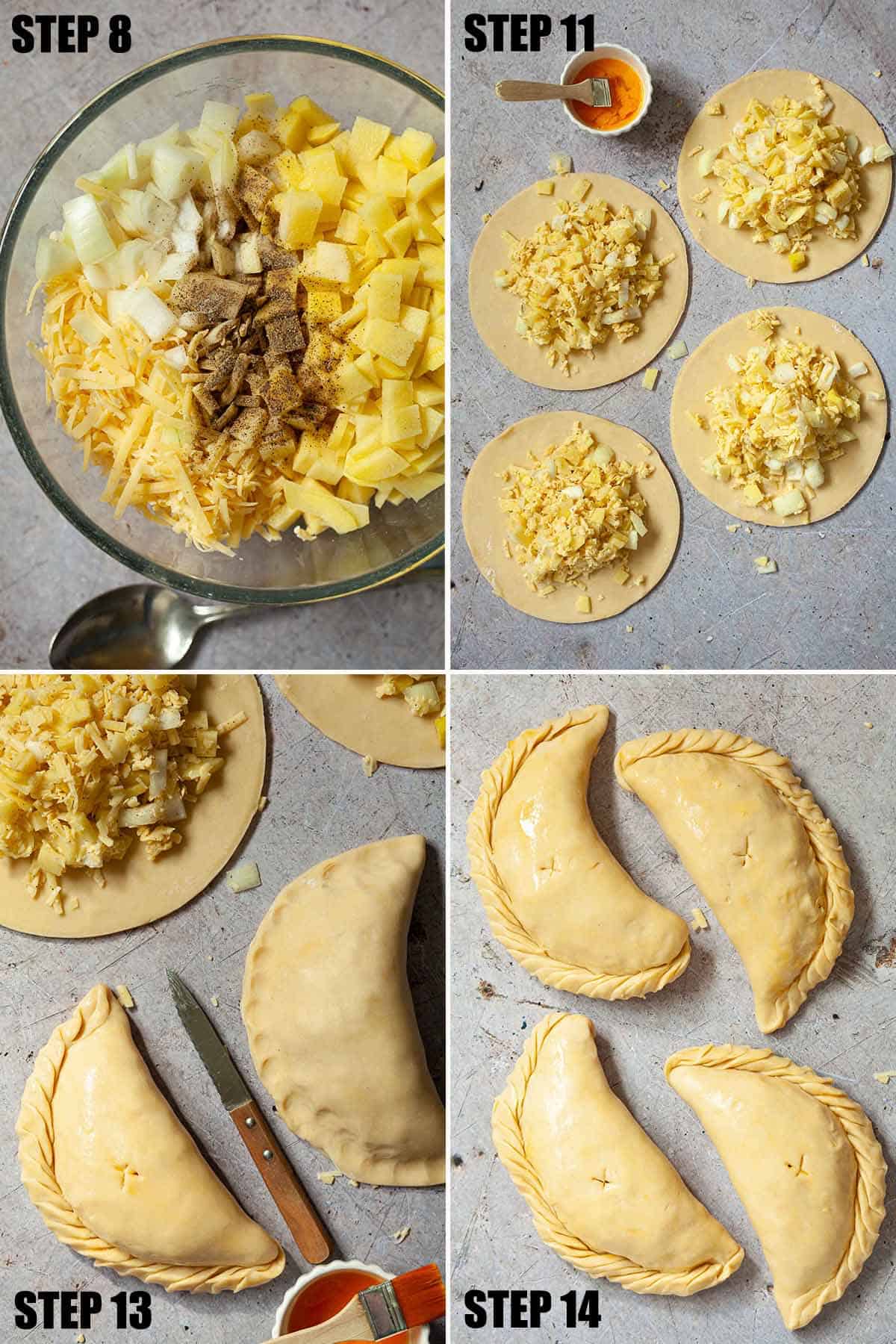
Expert tips
- Don’t skimp on the time required to knead the pastry or the chill time of the dough. Both are essential to ensure your pastry turns out well.
- Cut the potatoes and onion uniformly to ensure they cook evenly. See the images for an approximate size guide – don’t cut the potato too thickly as it will take too long to cook.
- Don’t be afraid to season the filling well, especially with black pepper. It makes a world of difference to the overall flavour of these cheese and potato pasties.
- When filling the pasties, you will perhaps think that there is too much filling. Do try to fit it all in – remember that the cheese melts during cooking, so they are unlikely to burst open in the oven but leaving some out will result in a disappointingly filled pasty once baked.
- Crimping is the best way to seal these cheese pasties. It also gives the pastry structure and it helps to prevent the filling from falling out. See my video if you are unsure how to crimp a pasty.
- Let these cheese and potato pasties cool for around 20 minutes before attempting to eat them, otherwise, they will be too hot to fully enjoy.
- If you need to reheat your pasty, please do so in the oven. Never microwave any pastry as it will end up soggy and that, my friends, is an atrocity. Pastry should always be treated with respect. Can you tell I have a fiendish love for pastry?
Frequently asked questions
The baking time for these vegetarian Cornish pasties is relatively long so there is no need to cook the onions and potato before using them to fill the pasties as they will soften during the cooking time.
Some recipes suggest caramelizing the onion or frying the potato beforehand, but I honestly find this a totally unnecessary step. In keeping with a traditional recipe for a meat pasty, I’ve kept the filling quick and simple to prepare.
Yes, you can make these vegetarian Cornish pasties gluten-free. Simply replace the regular flour with a suitable gluten-free alternative.
Alternatively, find a suitable readymade gluten-free shortcrust pastry and use that. You might struggle to find one made with bread flour, so expect the pasties to not be quite so robust – grab a plate if they are a little crumbly.
My preference is always a robust shortcrust pastry when it comes to any pasty as it holds its shape well and won’t crumble when picked up (because we all know that the best way to scoff a pasty is to pick it up and take bite after delicious bite whilst holding it in your hands).
If preferred, puff pastry could be used instead, but you may find it necessary to use a knife and fork when eating your cheese and onion pasties.
These cheese and onion pasties with potato are best eaten when freshly made but they can also be stored in the fridge for up to three days. To do so, let the pasties cool completely then cover them to prevent the pastry from drying out and chill until required.
To reheat place on a baking sheet and cook for 15-20 minutes in a low oven (150C/ 300F/ GM2).
Alternatively, freeze these cheese and potato pasties for up to three months. Defrost in the fridge overnight and reheat as instructed above.
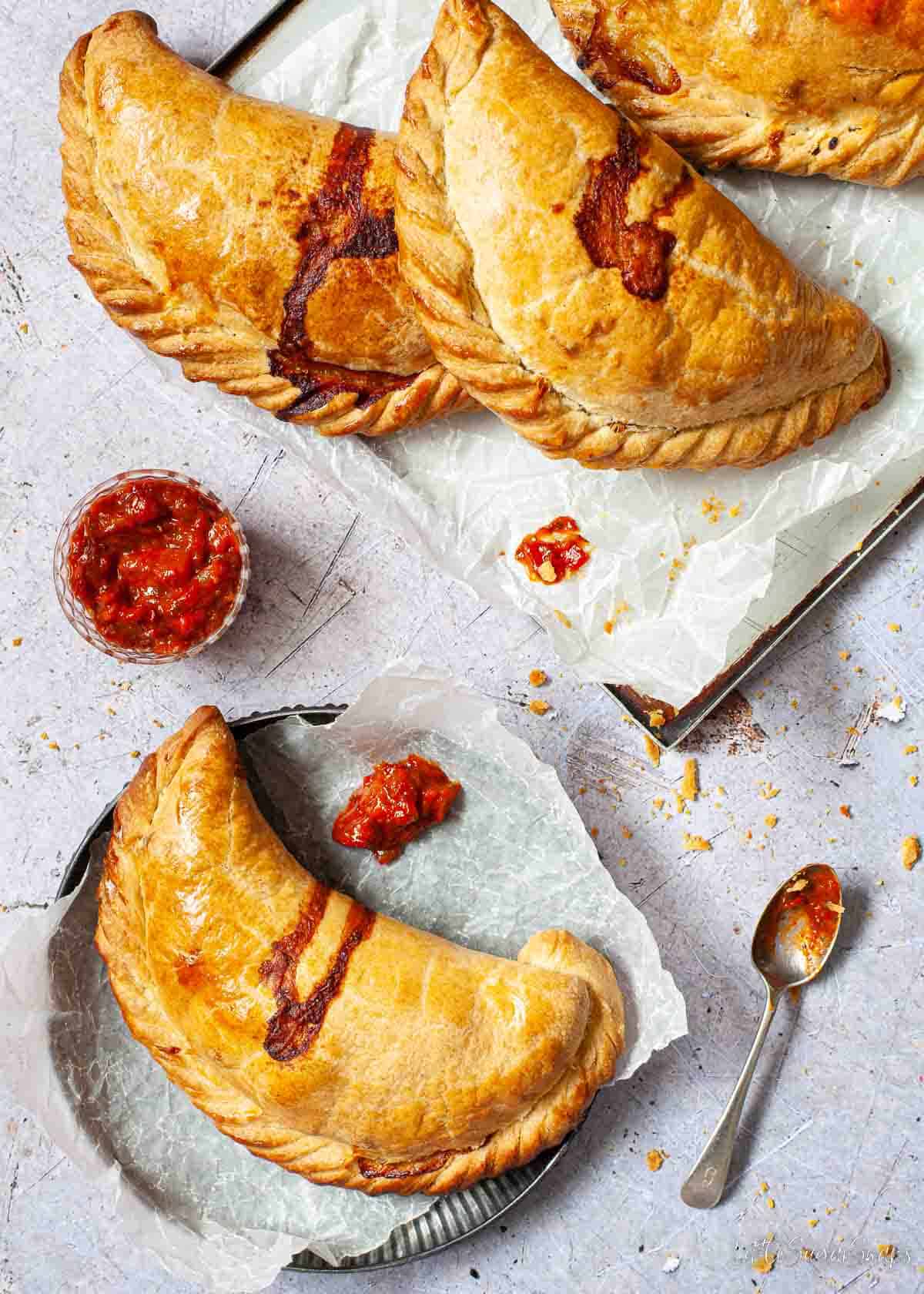
Variations
Try the following ideas to ring the changes in your cheese and potato pasties.
- Replace the onion with an equal quantity of leek. Just slice into thin rounds and then quarter each round.
- Vary the cheese. A good blue stilton is a good bet as it still has a strong and punchy flavour.
- Add some herbs. Try stripping the leaves from a few stems of thyme and mixing them into the filling.
More savoury bakes
Have you made these cheese and onion pasties? Please do let me know how you got along by leaving a comment and/ or a rating. It really does help other readers know that they can trust this recipe (and I always love to hear from my readers).
📖 Recipe
Want to Save This Recipe?
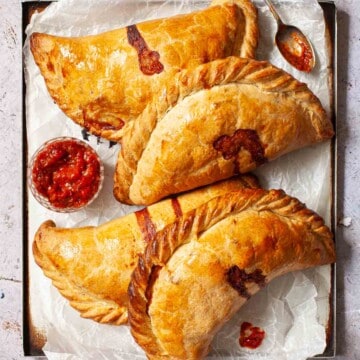
Cheese and Onion Pasties with Potato
Ingredients
Shortcrust Pastry
- 500 g Strong bread flour
- 125 g Butter
- 125 g Trex vegetable fat or other vegetable shortening
- ½ teaspoon Salt
- 1 Egg yolk
- 150 ml Water ice cold
Filling
- 200 g White onion
- 350 g Potato waxy
- 225 g Mature cheddar cheese
- ½ teaspoon Salt
- ¾ teaspoon Ground black pepper
Glaze
- A little beaten egg
Instructions
Make the Pastry
- In a large bowl rub the butter and vegetable fat into the flour and salt until it resembles breadcrumbs.
- Add the egg yolk and ¾ of the water. Mix with a blunt knife until a dough forms, adding more of the water as necessary. Make sure you add just enough to bring the dough together well but not enough to turn it wet and sticky.
- Knead on a lightly floured worktop for 3-4 minutes until the dough begins to feel elastic.
- Shape the dough into a disc and wrap it in clingfilm and chill for at least 3 hours. Bring the pastry out of the fridge 30 minutes prior to rolling it out.
Make the filling
- Slice the potato and onion into thin pieces in line with the filling of a Cornish pasty. It bakes wonderfully in the time the pastry takes to cook (see the step-by-step images for guidance).
- Coarsely grate the cheese.
- Put the potato, onion and cheese into a large mixing bowl, add the seasoning and use your hands to mix the ingredients together.
Assemble and bake the pasties
- Preheat the oven to 200C/ 400F/ Gm 6 and cover a large baking sheet with baking parchment.
- Divide the dough into 4.
- On a floured surface, roll each piece out to approximately 2mm thick and cut a 20-22cm circle from it (lay a plate or cake tin onto the pastry and cut around it).
- Share the cheese, onion and potato filling between the 4 circles.
- Take one pasty and brush egg wash around the edge of half of the circle then fold the dough over to encase the filling, pushing any stray pieces of filling back inside as you seal the pasties.
- Crimp the edge by using your index finger and thumb to push down and twist the edge of the pastry over to form a crimp. Repeat along the entire length of the pasty then tuck the ends underneath (see the video if you are struggling to visualise this technique)
- Repeat these steps with the remaining 3 pasties until they are all sealed and crimped.
- Place all the pasties onto a baking tray, slit the top of each one with a knife and brush all over with egg wash.
- Bake at 200C/ 400F/ GM 6 for 15 minutes then turn the heat down to 150C/ 300F/ GM 2 and bake for a further 45 minutes.
- Cool on a wire rack for at least 20 minutes before eating.
Notes
- Don’t skimp on the time required to knead the pastry or the chill time of the dough. Both are essential to ensure your pastry turns out well.
- Cut the potatoes and onion uniformly to ensure they cook evenly. See the images for an approximate size guide – don’t cut the potato too thickly as it will take too long to cook.
- Don’t be afraid to season the filling well, especially with black pepper. It makes a world of difference to the overall flavour of these cheese and potato pasties.
- When filling the pasties you will perhaps think that there is too much filling. Do try to fit it all in – remember that the cheese melts during cooking, so they are unlikely to burst open in the oven but leaving some out will result in a disappointingly filled pasty once baked.
- Crimping is the best way to seal these cheese pasties. It also gives the pastry structure and it helps to prevent the filling from falling out. See my video if you are unsure how to crimp a pasty.
- Let these cheese and onion pasties cool for around 20 minutes before attempting to eat them, otherwise, they will be too hot to fully enjoy.
- If you need to reheat your pasty please do so in the oven. Never microwave any pastry as it will end up soggy and that, my friends, is an atrocity. Pastry should always be treated with respect. Can you tell I have a fiendish love for pastry?

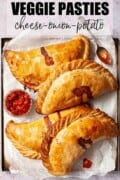
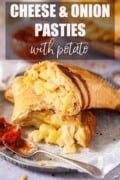
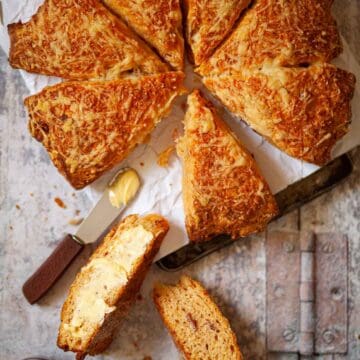
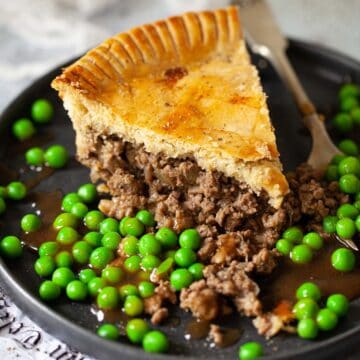
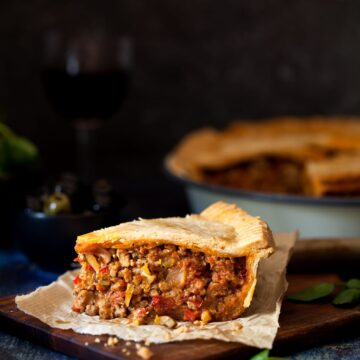
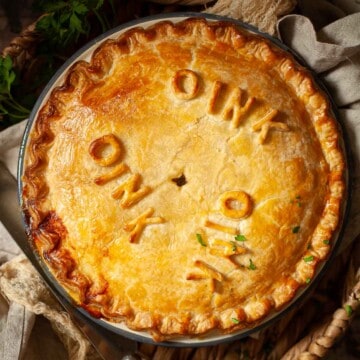
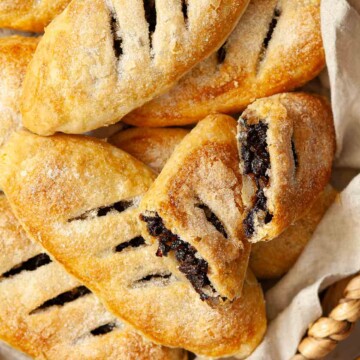
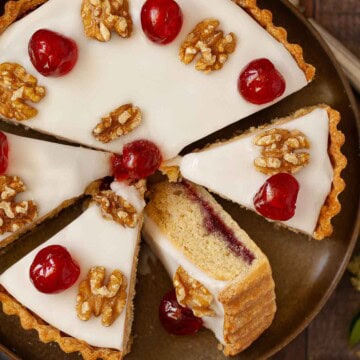
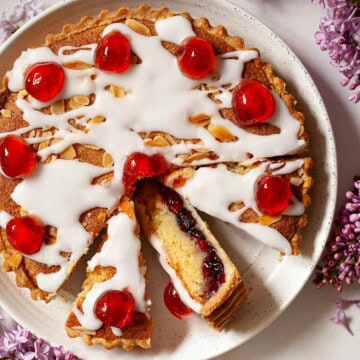
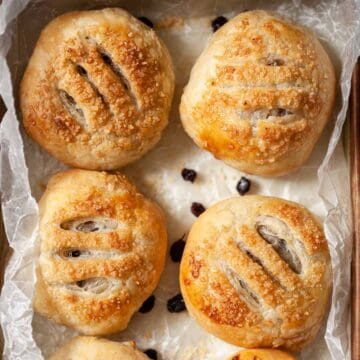
Frank
Love em…
Jane Coupland
awww thanks Frank! Me too 🙂
Jessica
This was an EXCELLENT recipe. I was very impressed – it tasted just like a classic Cornish pasty, but a much better version b/c it’s vegetarian. The pastry was easy to work with but so delicious and rich. I was surprised by the use of strong bread flour and the kneading, but I trusted the recipe and followed it exactly. The video for crimping the pasties was so helpful – it helped me to make it look very professional (even though I wasn’t that good at it!. Everything baked perfectly in the filling, and leaving it to sit for 20 minutes meant that we could enjoy it fully. The only thing I didn’t quite follow was I used just egg white for the wash, b/c I had some egg white that needed using and no whole eggs left.
Jane Coupland
Jessica, thank you so very much for your wonderful review. I’m a bit slow on the update on videos but this one seemed really worthwhile, so I went for it! Glad it proved helpful. I adore pasties… of all kinds (I have a severe pregnancy craving for them once upon a time – haha!).
Lorna
Thank you for this recipe. I was especially pleased to find I didn’t need to cook any of the pasty filling in advance. I cut the vegetables up pretty small (I cubed them roughly 5-10mm in size) and included celery and sweet potato, both of which worked well. I also combined cheddar cheese with 2 Laughing Cow cheese triangles, because that was what I had in the house, and it created a lovely creamy coating for the veg. The filling was perfectly soft within the hour, with lovely crisp pastry. I would definitely make these again, and try it with strong bread flour, because I used spelt, which tasted good but made quite a crumbly pastry that was a challenge to roll out.
Jane Saunders
Hi Lorna, thanks for your lovely comment. I’m so pleased you enjoyed the and also found a way to customise them. I love spelt flour, but I’ve never tried making pastry with it. I guess as long as you had a plate to hand to catch the crumbs it wasn’t a problem 🙂